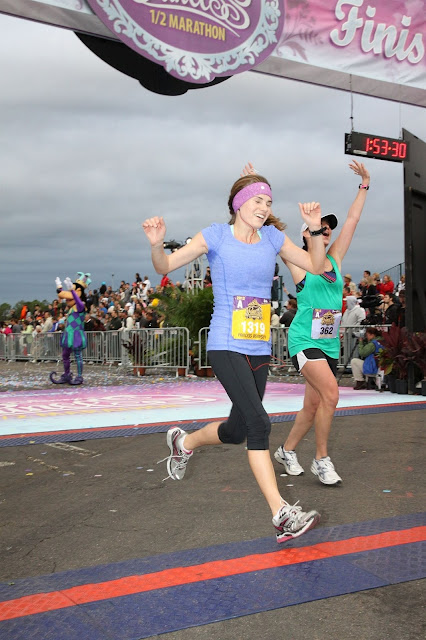Running is hands down my favorite form of exercise. It’s cheap and simple and there’s
nothing like the endorphin rush after a good run. But I didn’t always love running. In fact, for a good period of time, I hated it. I can still recall my first attempt at
running my freshman year of college.
I threw on my shoes, plugged in my iPod, and sprinted out the door of my
dorm, excited to embrace all that was the world of running. Unfortunately, while my mind was
anxious to get out there and try new things, my body was not. I made it five minutes before I was
stopped in my tracks out of breath, with debilitating side stitches, thinking
that I was actually going to die.
 |
| Nike Women's Half Marathon 2011 |
Needless to say that running did not come easy for me. I was small and athletic—I certainly
had the body of a runner. But my
lungs were simply not conditioned for aerobic activity. I, however, was determined to fall in love
with running. After months of
trying to start running and quitting (this happened at least five times), I finally
decided to stick with it.
It was not easy.
In fact, it was incredibly difficult. But how did I do it?
I opted to skip the popular Couch to 5k program and instead started out
by running one mile and recording my time. The next day, I tried to beat that time. And the day after that, I tried to beat
that time. Once I got semi-comfortable
running a mile, I upped it to 2 miles (I know, BIG TIME!) and continued the
process. I aimed to complete one “long”
run a week in which I ran an extra five minutes longer than I usually did. All the while, I recorded my
times. I still have my first
recorded week of running! Check
out how slow I was:
Day
1 (Wednesday March 30)- 1 mile 10:30
Day
1 (Wednesday March 30)- 1 mile 10:20
Day
2 (Saturday April 2)- 1 mile 9:59
Day
3 (Sunday April 3)- 1 mile 9:30
Day
4 (Monday April 4)- 1 mile 9:11
Day
5 (Wednesday April 6)- 2 miles 19:50
At this point, I decided to sign up for a half-marathon so
that I would have a goal to be working towards. I signed up for the Nike Women’s Half Marathon in San
Francisco (the one where you get a Tiffany’s necklace at the end from a
firefighter in a tuxedo!) I think
the key to my so-called success was writing down my daily runs. Being able to look back and see my
progress was motivating and inspired me to push hard every day. It was by no means easy, but I was
determined to become a runner.
 |
| Finishing the Disney Princess Half Marathon in 2012 |
To make a long story short, I completed my first half
marathon in 2:08:38 (9:48 min/mi) in October 2011. Since then, I have run 3 other half marathons and dropped my
PR down to 1:49:41 (8:22 min/mi)!
Remember, this is the girl who had to stop five minutes into her first
run. If I can learn to love
running, anyone can!
 |
| After my first ever half marathon with my friend Michele |
If you’re just starting out running, here’s my tips:
- Make a plan. Whether you decide to follow a Couch to 5k program, or go my route of running a mile and slowly upping your distance while trying to improve your times, having a plan is a huge key to success.
- Record your results. This was essential for me! I needed to be able to look on paper and see my improvement or I lost motivation. Write your runs down in a notebook, a word document, or get fancy and record them on a website like this.
- Get an app that records your pace. This was also a huge key to my success. It allowed me to run outside (way more fun than on a treadmill) while still knowing my distance and pace. I suggest Nike+ or Runtastic.
- Get equipped. Running does not require much equipment, but good running shoes are essential to running comfortably and staying injury free. Go to a local running store and have your gait analyzed so they can fit you with a good pair of shoes.
- Don't be afraid to push yourself. Get comfortable with being uncomfortably. Running is all about pushing your limits, whether it's running a little bit faster or going a little bit longer. It's tough when you're doing it, but the reward is worth it.
- Sign up for a race! Having a goal to work towards is an amazing motivator. Plus, once you run one race, you'll be addicted. The crowds, the energy, the endorphins, the adrenaline. It's amazing!
 |
| Disney Princess Half Marathon! |
Good luck and Happy Running!



